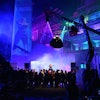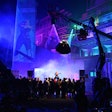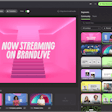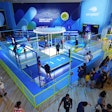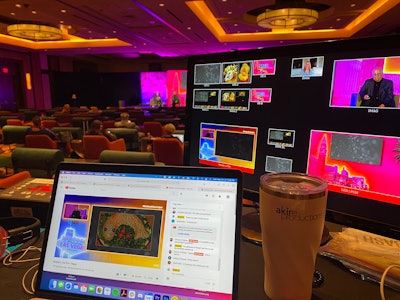
Events look different than they did last year, or even pre-pandemic. A glorified Zoom call or livestreamed keynote speaker isn't going to do the job anymore. Instead, today’s best events have a storyline that weaves from one element to the next, encourages engagement from every attendee—in-person or virtual—and are equal parts live interaction and technology. Here are the shifts we need to make as event producers to meet these new guest expectations.
 Erika Lohmar is the president and executive producer of akire productions, where she produces in-person, online and hybrid events for corporations, schools and nonprofits. She’s based in Chicago.Photo: Courtesy of akire Productions
Erika Lohmar is the president and executive producer of akire productions, where she produces in-person, online and hybrid events for corporations, schools and nonprofits. She’s based in Chicago.Photo: Courtesy of akire Productions
Most events now are hybrid, and that means staffing for both in-person and online elements. With suitable staffing, marrying the engagement between live and online attendees becomes easier. For example, if an online attendee submits a question during a presentation, the staff in charge of the app can feed the question to the speaker on the stage, bringing an added sense of cohesion to the event. Allowing guests in various locations to feel like they are connected, whether in person or virtually, creates a storyline that is carried through the hybrid event.
Additionally, in creating the bridge, having a broadcast expert on your team to navigate the back end of each platform to properly stream, connect and execute makes this experience flawless for the audience, the producers and the technical teams.
2. Tech rehearsals are more important than ever.
With the integration of in-person and virtual, along with the current supply chain/labor demand, we need to have more time to build our activations, stages and AV installs, along with proper timing for rehearsals. Although speakers may be able to walk in and check a mic, your tech teams need the space to set up—and it’s taking longer with fewer team members.
In addition to your in-person tech check, you have all the virtual components as well. Have you ever had a portion of your event online and some tech issue erupted in comments and tech support inquiries? It happens often—but can be avoided. Plan extra time to run tech rehearsals in the room as well as from desktop and mobile.
We are here to make everyone look good and sound good, remote or on-site, so help set that expectation and explain to presenters the importance of tech check and rehearsals. This hasn’t necessarily changed with the world we are in, but the importance and timing for it has. Many presenters are high-level executives, so plan ahead for busy calendars and block out the proper time. They will thank you for it—even if they don’t understand why at the moment.
3. Hire an emcee.
Real talk: Tech issues happen. An emcee is a perfect person to communicate about it in real time and do a lot of heavy lifting during the event. This person ties together different elements of the event, and can communicate any issues like a tech snafu or a speaker lineup change. They can also offer "commercial break" content for live attendees.
4. Planning ahead is key.
Organize every asset involved in the event. Our hot tip: Label all your creative assets to match your cue numbers on your run of show. Streamlining this process creates easy access for any event staff member, but your content designer and video and graphics directors will love you! The entire event should be able to run beginning to end from the information you've compiled on your run of show and files.
You also need to consider what happens if an “emergency” occurs. Make sure to have graphics built for these moments. No client, tech team member or producer likes a black screen, other than for a dramatic theatrical moment. With your system in place, you need to have a backup plan so that all parties, in person and virtual, understand how they're supposed to proceed in these instances. Especially if a team member needs to be replaced at the last minute, it’s easy to step in when it’s all labeled and ready to go.
Additionally, ensure that the content branding is cohesive for all experiences, whether at home or on location. Graphics and logos—can there be too many? With broadcast graphics of picture in picture (PIP), lower thirds, branded Zoom backgrounds and branded platforms, make sure to take the whole picture into consideration when designing the experience.
5. Talk tech like a native.
As an event producer, you need to be able to talk tech lingo like you’re an expert. It makes it much easier to collaborate with a tech team if you understand their terminology. For example, does your video director prefer cue numbers or presets? How do they like to set up their presets? Do you even know what presets are?
Once you understand the technical terms involved for each position for the event (audio, visuals, lighting, graphics, cameras, etc), you are speaking their language and can efficiently tighten up communication, allowing more time for accurate rehearsals and less room for error or misunderstandings. How did I learn? By literally taking some down time to sit with the audio director and ask the questions—like what do you listen for? What does this button do on your massive board? Oh! I shouldn’t touch that, noted.
6. R-E-S-P-E-C-T.
In-person attendees are braving the event world for the first time in a while, so create an environment that they feel comfortable. For BizBash Las Vegas and several of our in-person events, we’ve provided bracelets that indicated comfort levels. For example, if you were comfortable with hugging, you have one color, and if you prefer to stay 6 feet apart, you have another. Offer various ways to maintain your attendees’ comfort levels, like requiring negative COVID results or vaccination cards before entering the event.
Not only has this made us more aware of others' comfort level for health considerations, it has also made us more conscious of planning for personality types and continued learning styles. We feel like this opens up a word of opportunity for those who are more introverted or particular about germs, space, etc. We created possibilities to allow people to be themselves and allow others to respect that space. It’s now more accepted to say, ‘I’m here, I want to see your smiling face, but I may just want to wave and talk a bit from a distance—and that is a-okay.’
Producing events in 2021 brings so many growth opportunities. With the surge of attendees enjoying virtual learning opportunities, event producers have the chance to integrate virtual and in-person activities even more. We expect the future holds even further adoption of virtual learning paired with more intentional and impactful in-person gatherings.
